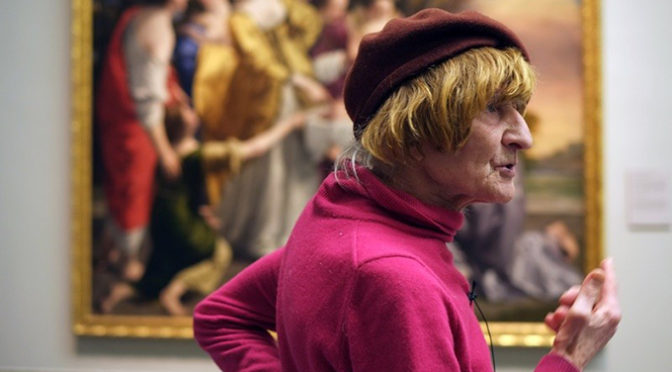
This brief glimpse into the life of Soviet musician and composer Oleg Karavychuk proves as meandering and occasionally mesmerising as its subject.
The elegantly composed shot of an ornate palace corridor with which OLEG AND THE RARE ARTS opens may suggest that the audience is in for an hour or so of ‘gallery porn’, whose rapt contemplation of objects of beauty comes across like so much wallpaper. However, that impression is immediately overturned by the entrance of the slight, eccentric figure who will be the sole subject and speaker of this film: Oleg Karavychuk. On first glance it is not even clear whether this wizened, oddly outfitted individual is male or female: the wavering voice is very high, the hair all too obviously a wig. We quickly learn from Oleg that this beautiful room is somewhere in the Hermitage Palace in St Petersburg, but the rest of his conversation goes off on various strange tangents involving Catherine the Great. (Oleg, it soon emerges, is a very big fan of Russian royalty — and also, as it turns out, the ‘Great Leader’, Stalin.) His subsequent remarks during the film rarely come down to earth.
Oleg’s fondness for ‘dissonance’ may prove the film’s undoing.
The documentary’s director Andrés Duque doesn’t seem to go in for context, preferring to let his subject do the talking and the playing, neither of which reveal very much which the audience can use as an reference point. Oleg — a name we only learn when the credits appear at the end — makes occasional references to a career as a film composer and pianist, and a few disparaging remarks about ‘the Philharmonic’, evidently representing the Russian musical establishment, imply that he was something of an outsider. There is also a throwaway comment about being banned in some way. However, he appears to be allowed to play a piano in the Hermitage that belonged to the last Tsar, Nicholas II, and evidently treats the instrument very much as his own.
Much of this short documentary is given over to Oleg’s piano playing, which is quite as free-flowing and sometimes jarring as his conversation. He may play a pretty tune in the right hand, for instance, but then accompany it with brutal chord clusters by bringing down his whole left fist on the keys. (His pianistic style occasionally resembles Chico Marx’s.) How much the viewer — or in this case, listener — can go along with these performances will probably determine how much they can get out of this film. For many audience members, Oleg’s fondness for ‘dissonance’, which he discusses at length during his final performance, may prove the film’s undoing.
Duque’s key achievement in this documentary is to let Oleg be, for good or ill.
It’s never clear what prompted this documentary, although as Oleg admits in a typically rhapsodic letter to the Queen of Spain, he is 88 years of age and thinking of his ‘legacy’. Oleg is quite convinced of his own genius, and appears highly sensitive to some unexpected obstacles that stand in the way of the fulfilment of this genius: Dutch greenhouse cultivation and synthetic fabrics, for instance. His attachment to beauty is evidently sincere, however, and Duque’s key achievement in this documentary is to let Oleg be, for good or ill. In the same way, Duque often seems content to let Oleg dictate where a scene ends: more than once, apparently exhausted by an improvisation on the piano, he cries, ‘Enough!’ and the picture cuts to black.
It may be that Oleg is a deluded nostalgist, but it’s equally possible that he has a genuine insight into the transcendent effects of art. His joyously entertaining music-making at the end of the film may just be enough to convince us of the latter.
httpvh://www.youtube.com/watch?v=ozJy0prl_RQ

